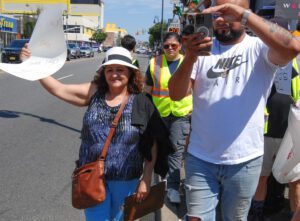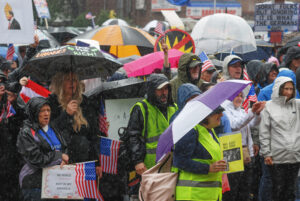By Madeline Armstrong
“All of us have a history related to World War II,” Christopher Vega, a New York history professor at Suffolk Community College, told attendees during an April 11 seminar exploring the role that Long Island played in World War II, hosted by the Uniondale Public Library via Zoom.
Vega presented his research titled, “World War II and Long Island: The Home Front.” He began with the National German American Bund, an alliance that promoted German values and Americanization, which was prominent on Long Island and formed alliances with the Christian Front and Protestant Civic Welfare. The movement eventually devolved into Nazism and anti-Semitism, according to Vega.
Additionally, Everett Roeder, a Nazi spy from Merrick, was a top engineer with the Sperry Gyroscope Company in Garden City. The work that he did there gave him access to bombsights, long-range guns and cutting-edge autopilot technology. According to Vega, Roeder shared the information with the Nazi Luftwaffe fighter plane production lines, and by the 1940s, all Nazi planes were equipped with technologies from Sperry’s Gyroscope Company.
Vega also said the FBI discovered the Benson House in Wading River was a Nazi safe house that was transmitting radio information back to Germany. Once it was found, however, U.S. officials fed counterintelligence messaging through it. “Not many people had an idea about the Nazi spy rings,” Vega said.
Although Long Island was the hub for a significant amount of Nazi sympathy and anti-Semitism during the Second World War, many Long Islanders contributed to fighting Germany.
Nancy Leftenant, from Amityville, was the first Black military nurse in reserve or active duty. “God bless her because she saved countless people’s lives,” Vega said. Also, the majority of the Women Auxiliary Service Pilots were stationed on the Island. “The majority of the planes coming out to fight the war [came] from Long Island,” Vega said. The women tested the planes by towing moving targets through the air and delivering the planes for service.
Another significant contribution to the war effort was the scrap metal raised in Rockville Centre. In 1943, the federal government placed a quota on local villages to raise scrap metal. Rockville Centre had a quota of 700,000 pounds and held the record across the country. According to Vega, 125 pounds of metal for each of the 5,000 homes across the village was raised — enough to build 35 tanks.
There were other unexpected finds in Vega’s research. “The prisoner of war camps were another thing that surprised me,” he said. Long Island was home to three POW camps during World War II.
Vega also noted that Long Island was transformed from a primarily rural, agricultural region to a hub of modernity during the war. “It’s amazing how Long Island modernized in such a short time, and it’s pretty much unrecognizable,” he said. “The growth of mass consumerism is a product of World War II.”
And Vega attributed the civil rights movement to the war. “World War II paved the way for the civil rights movement,” he said. “After defeating tyranny abroad, [African-Americans] expected something different here.”
Vega said he believes Long Islanders should know the history of their region during the Second World War. In many ways, this significant historical period shaped the Island that people call home today.








